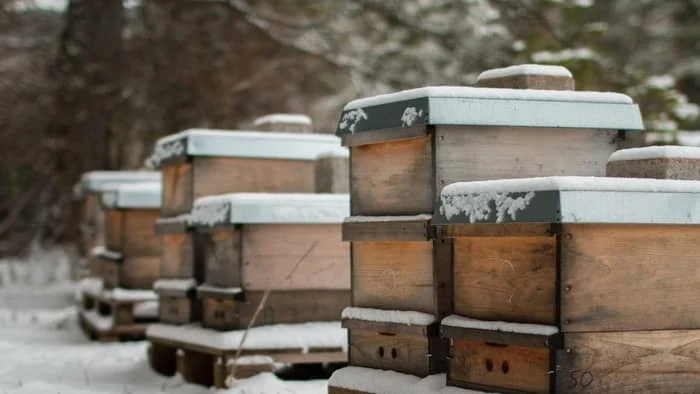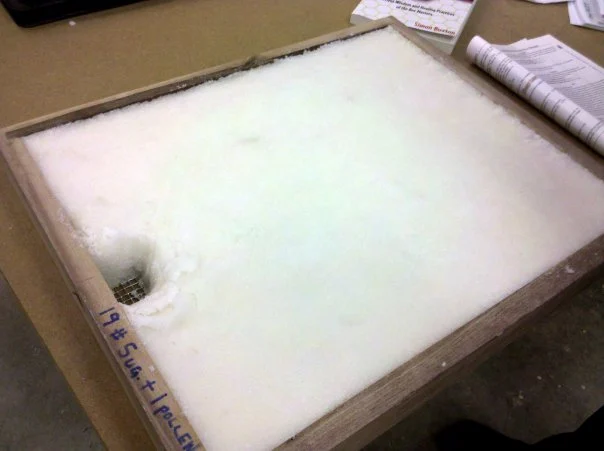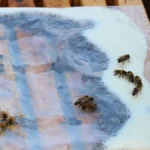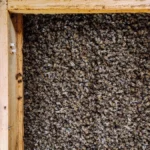There are many ways that we can feed our bees. A candy board is a clever way to help our bees make it through a cold winter. In this article, we look at how to make a candy board for bees using simple methods.
In a cold winter, bees have to live completely off their stores for the snow-bound parts of winter. During this time the bees form a cluster and huddle together and slowly move around the hive consuming their stored honey. As honey is consumed, it is converted to heat, carbon dioxide, and water.
Bees overwinter well in hives fitted with a small entrance at the top of the hive. This is because they tend to cluster near the top of the hive – warm air rises. We are able to encourage a flow of air from the small vent at the base of the hive, through the cluster, and out of the top of the hive. In this way, we reduce the risk of moisture building up in the hive.

What Is A Candy Board For Bees?
Moisture build-up in beehives is a big problem in winter and can cause bees to die. A candy board is a block of crystalline sugar placed at the top of the hive. The board is made in such a way that air leaving the hive is drawn over the board.
If moisture condenses, it drips into the sugar block and dissolves sugar. Bees can consume this sugar, metabolize it and turn it into more heat, moisture, and carbon dioxide. In this way, the bees are able to derive food from moisture which would have been a problem for them. We turn a problem into a solution.

A Candy Board Recipe For Bees
With a candy board, we are taking granulated white table sugar and adding just a little water to it and a very small amount of vinegar. The reason we use this mix is quite simple. A small amount of water will dissolve some sugar. This sugar will be sticky. If we mix this sticky sugar into the rest of the sugar it will glue the sugar together much like cement sticks concrete together.
We add a little vinegar to the solution so as to acidify the candy. Lower pH solutions inhibit the growth of mold in the candy board in winter. This is useful as it avoids the bees being exposed to fungal mycotoxins.
Tools Needed
5 Gallon Bucket/pail
Small spade for mixing. (When I wrote this I discovered I have been calling a spade a shovel for 40 years)
measuring cup or jug
a tablespoon measure
Ingredients
Clean water
16 lb sugar
White spirit vinegar (minimum 4-5% acidity as labeled on the bottle)
Candy Board
You can purchase a candy board from a place like this.
Mixing
Place the 16 lb of sugar in a bucket. Mix a tablespoon of vinegar into three cups of water and slowly mix this into the sugar using the spade. You can use a sort of digging and then stirring motion and try to get the entire sugar volume just a little damp.
Setting The Candy Board
After you have mixed the sugar and acidified water, you can place it into the candy board. Place the candy board on a flat surface (a hive lid works well) with the mesh facing down. If you bought a board like this you need to place a wooden block over the entrance hole and in each back corner, left and right.
You can now put the candy mix into the board and tamp it down. Some people suggest putting paper down before putting the candy in. This is unnecessary and restricts the bee’s access to the candy, as well as potentially introducing pollutants into your hive.
The reason you put a wooden block over the entrance hole and on each rear corner of the board is that once the candy is formed, you can remove these. This gives the bees an access point to the entrance, and some ventilation holes at the back that will draw moist air over the board.
If you made your board like this you do not need to worry about putting blocks in the corners or over the entrance, because the design of the board actually precludes the need for this. That is why that design is so clever.
Allow the candy board to set overnight, or a day or two.
Placing The Candy Boards On Your Beehives
In your final preparations for inter, place the candy board directly onto the top frames of your hive. You should at this point already have reduced the entrance holes at the base of the hive to their winter configuration.
If you used the first design shown, you will need to place two small strips of wood across the frames in your hive – this stops the candy sagging onto the frames and restricting bee movement. If you used the second design you need not worry about this.
Place the inner cover and then the lid on top.
Candy Boards and Small Hive Beetles
As small hive beetles spread around the world, it makes it harder and harder to mix pollen or pollen substitute into your candy board mix. If you mix pollen or pollen substitute into your candy board mix and a small hive beetle is in your hive, it will multiply in your candy board and cause complications.
Hence my advice in these changing times would be to minimize the use of pollen mixes in candy boards.
What To Do With Leftover Candy Board Sugar In Spring
As you perform your spring management you can collect the leftover sugar in the candy boards and dissolve it in water to make your spring sugar syrup for feeding the bees.
We hope this article helped you decide on whether to include candy boards in your management routine. If you found this useful, please share.
Read more about: Bee Foundation Plastic vs Wax

Dr. Garth A. Cambray is a Canadian/South African entrepreneur and beekeeper with 28 years of experience in apiculture and specializes in adding value to honey. His Ph.D. research developed a new advanced continuous fermentation method for making mead that has resulted in a number of companies globally being able to access markets for mead. His company, Makana Meadery, exports honey mead to the USA where it is available to discerning connoisseurs. He has also developed technologies to commercially manufacture organic honey vinegar in Zambia for export globally. He holds a few patents globally in the ethanol industry and believes in technology and knowledge transfer for human development and environmental sustainability. One of his proudest achievements is the fact that the wind farm he started at one of his old apiary sites has essentially made his hometown carbon neutral.






